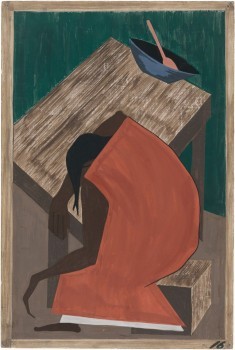afterword
 Lately I’ve been writing at the very end of the day (except for Sunday when I didn’t leave the house and churned out 1500 words). The goal is to write 500 words a day for the month of August, but right now I’m at 6500 when I should be at 8500. Some progress is better than no progress at all, and I’m trying to be forgiving when I fall short or miss a day. I realize I’m making things harder because I’m trying to finish chapters in sequence and won’t let myself jump ahead when I get stuck. I just stay there, staring at the screen, until I find a way to fill in the blank. Then I get up and do some stretches or have a snack (more snacking than stretching, unfortunately, now that my sugar fast has ended). Today I’m thinking about the afterword I need to write for one of my forthcoming picture books, Billie’s Blues. I keep referring to it as “my lynching book,” but it’s really about the Great Migration. There is one illustration at the end, however, that points to the racial violence that prompted so many African Americans to pack up and move. I’m working with my amazing Hong Kong illustrator again and she just sent me this sketch, which was inspired by two Jacob Lawrence paintings I sent her for reference. Have you ever talked to your kids about lynching? When I first taught my course on gender, terror, and trauma at Ohio University in 2002, my students were angry that they were only learning about lynching in college when they had
Lately I’ve been writing at the very end of the day (except for Sunday when I didn’t leave the house and churned out 1500 words). The goal is to write 500 words a day for the month of August, but right now I’m at 6500 when I should be at 8500. Some progress is better than no progress at all, and I’m trying to be forgiving when I fall short or miss a day. I realize I’m making things harder because I’m trying to finish chapters in sequence and won’t let myself jump ahead when I get stuck. I just stay there, staring at the screen, until I find a way to fill in the blank. Then I get up and do some stretches or have a snack (more snacking than stretching, unfortunately, now that my sugar fast has ended). Today I’m thinking about the afterword I need to write for one of my forthcoming picture books, Billie’s Blues. I keep referring to it as “my lynching book,” but it’s really about the Great Migration. There is one illustration at the end, however, that points to the racial violence that prompted so many African Americans to pack up and move. I’m working with my amazing Hong Kong illustrator again and she just sent me this sketch, which was inspired by two Jacob Lawrence paintings I sent her for reference. Have you ever talked to your kids about lynching? When I first taught my course on gender, terror, and trauma at Ohio University in 2002, my students were angry that they were only learning about lynching in college when they had  studied the Holocaust as children. Few had studied slavery in school, though most had done a Social Studies unit on the Civil Rights Movement. So what do you say to a child about lynching without leaving her terrified? What do you say about police brutality without making your child afraid to turn to a copy when in crisis? I’ve been having these conversations with friends for a while now. I don’t have children but I’m an educator and an auntie, and I feel an obligation as a writer to “teach the youth the truth.” Not the whole truth, and not all the time. A 5-year-old isn’t ready for a conversation about lynching. But an 8-year-old IS ready to talk about the way justice is subverted by mob violence. College students can handle the graphic, gruesome details of lynching, but that doesn’t mean younger children shouldn’t be exposed to this part of US history. Billie’s Blues is mostly about a little girl spending
studied the Holocaust as children. Few had studied slavery in school, though most had done a Social Studies unit on the Civil Rights Movement. So what do you say to a child about lynching without leaving her terrified? What do you say about police brutality without making your child afraid to turn to a copy when in crisis? I’ve been having these conversations with friends for a while now. I don’t have children but I’m an educator and an auntie, and I feel an obligation as a writer to “teach the youth the truth.” Not the whole truth, and not all the time. A 5-year-old isn’t ready for a conversation about lynching. But an 8-year-old IS ready to talk about the way justice is subverted by mob violence. College students can handle the graphic, gruesome details of lynching, but that doesn’t mean younger children shouldn’t be exposed to this part of US history. Billie’s Blues is mostly about a little girl spending  a fun afternoon with an elderly neighbor—they listen to blues records and dress up in vintage clothes. But then Ms. Marble tells Billie why she left the South:
a fun afternoon with an elderly neighbor—they listen to blues records and dress up in vintage clothes. But then Ms. Marble tells Billie why she left the South:
The moon turned red the night they came
and took my Jim away.
The moon burned red the night they came
and took my Jim away.
Now that they done took my man,
there’s no reason to stay.
Make a point. Open a door. Start a conversation. That’s what I want my books to do…



